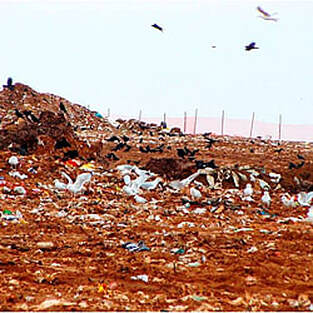|
Wildlife Control at Waste Management Facilities
At Loomacres, we share in the commitment of Solid Waste Facility Managers, to protect human health and safety by helping to provide a safe environment for personnel and the general public. The staff at Loomacres also understands the special requirements wildlife needs. Too often these needs collide creating an unsafe environment. The first step in solving any problem is to understand the situation. Your landfill has the opportunity to utilize a company that provides the comprehensive services that are encompassed in Integrated Wildlife Management. Many populations of wildlife species commonly involved in strikes have increased markedly in the last three decades and adapted to living in urban environments, including near landfills. The wildlife species and the size of the populations attracted to landfill environments vary considerably, depending on several factors, including land-use practices. Loomacres recommends that all landfills have at least one site visit. We also strongly encourage landfills to conduct a Wildlife Hazard Assessment in order to prevent catastrophic events such as birdstrikes. In recognition of the increased risk of serious aircraft damage or the loss of human life that can result from a wildlife strike, the FAA may require the development of a Wildlife Hazard Management Plan (WHMP) when specific triggering events occur on or near an airport. In addition, landfill operators must deal with a number of factors when running a site, one of which is almost always conflicts with wildlife. Birds are attracted to landfills because they provide an easy food source to exploit, along with an ideal habitat for loafing and nesting. Too often, bird numbers become so great that the site operator must take action to reduce their numbers. There are many great reasons to utilize Integrated Wildlife Management on your landfill to reduce wildlife populations. Reducing the bird population on your landfill will reduce the chance of a bird strike over your property and your liability as a landfill operator. Large congregations of birds lead to vast amounts of bird waste which can harbor harmful bacteria such as salmonella, E. coli, and histoplasmosis. Large congregations of birds, especially gulls, are loud and can cause annoyance. Reducing bird numbers means reduced noise complaints from neighboring businesses and residents. However, loud noises aren't the only annoyance issues birds may cause. Many large birds such as gulls, herons, and raptors may cause issues with neighbors because of the trash they pick up on the landfill and drop offsite. Birds can be a vector for trash and possibly disease to surrounding areas. Minimizing bird populations on your landfill will minimize the liability of birdstrikes, improve the overall health and appearance of your community and decrease noise and pollution. We believe an integrated approach is essential to successfully harass wildlife. As each landfill's situation is unique, methods will vary from landfill to landfill. We can also make recommendations for reducing the attractiveness of your landfill to wildlife; through habitat modification and the installation of dispersal and exclusion devices during a site visit. For more information please contact Clayton M. Jones, Lead Wildlife Biologist at 800-243-1462 (ext. 512) or at [email protected]. - Ecological studies; ......*Wildlife surveys - Permit Compliance; .....*State and Federal - Wildlife Hazard Management Plans; .....*Development and updates -Wildlife Conflict Resolution; .....*Hazardous Wildlife, Prevention, Removal, & Control -Training; .....*Wildlife Identification .....*Wildlife Hazard Management .....*Pyrotechnic and Firearms Safety |
